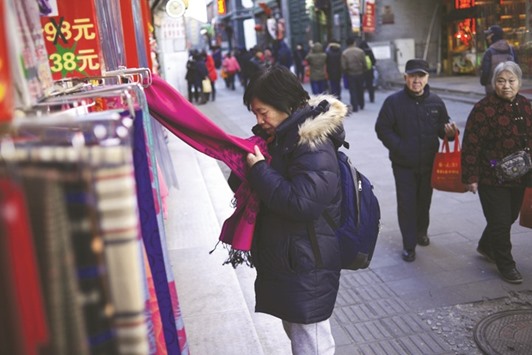China’s producer prices rose at their swiftest pace in more than five years in December, the government said yesterday, in a sign the world’s biggest trader could begin exporting inflation to the global economy.
China’s performance affects trade partners ranging from Australia to Zambia, many of which have for years been mired in tepid inflation which has in turn caused a drag on the global economy.
China’s own firms have been battered by falling prices for their goods in the face of chronic overcapacity and weak demand, dampening growth in the world’s second largest economy.
The stronger than expected producer price numbers came as a top official said that the country had likely hit its 6.7 economic growth target in 2016.
The producer price index (PPI) rose 5.5% year-on-year last month, the National Bureau of Statistics (NBS) said, far more than economists’ expectations of 4.6% in a Bloomberg News survey.
It marked the fourth straight month of price rises for goods at the factory gate after years of declines, and an acceleration from the previous month’s 3.3% – raising expectations China’s factories could put upward pressure on global prices through the supply chain.
But uncertainty hangs over the outlook as trade tensions may surge under incoming US president Donald Trump, who has promised to declare China a currency manipulator and threatened punitive tariffs on its goods.
Rising prices for industrial commodities helped support the forecast-beating PPI figures, the NBS said, as world producers cut supply.
The consumer price index (CPI), a key gauge of retail inflation, rose 2.1% year-on-year in December, slightly below expectations.
The figures were affected by warmer temperatures across China, which led to weaker-than-average price increases for fresh fruits and vegetables in the month, NBS analyst Sheng Guoqing said in a statement.
“The big picture is that consumer price inflation has moved within a narrow range around 2% over the past year and remains at a comfortable level for policymakers,” Chang Liu, analyst for Capital Economics, said in a statement.
Looking ahead, inflation figures are likely to leap in January due to higher oil prices and food price increases for the Lunar New Year holiday, possibly driving the CPI to its highest level since 2013, he added.
But he noted “the pick-up will mainly be driven by movements in commodity prices and is unlikely to be sustained”.
Protracted falls in factory gate prices are a bad sign for industrial prospects and economic growth because customers delay purchases in hopes of cheaper deals in the future, starving companies of business and funds.
China’s GDP expanded 6.9% in 2015 – its weakest in a quarter of a century – and the government had targeted growth in a range of 6.5%-7% for 2016.
But the ongoing rebound in producer prices could help boost nominal GDP growth in 2017, Zhao Yang of Nomura said in a note, though real growth “still faces plenty of headwinds from a cooling property market and potential deleveraging in the economy”.
He added that higher-than-expected inflation increases the risk of monetary tightening, limiting growth.
“We believe China is heading into a period of stagnation in 2017.”
China’s economy was estimated to have grown around 6.7% in 2016, the nation’s top economic planner told a press conference yesterday, matching widespread expectations and annual targets even as the country enters a year of uncertainty.
Looking ahead to Trump’s potential influence on the economy, Xu Shaoshi, director of the National Development and Reform Commission, said that “over the course of rapid development, there are some differences on certain issues and some frictions on others.”
The two countries should constantly seek to resolve such differences “for the benefit of both country’s peoples, and the whole world”, he added.

A woman selects a scarf at the entrance to a store along a street in Beijing. China’s producer prices rose at their swiftest pace in more than five years in December, the government said yesterday.
